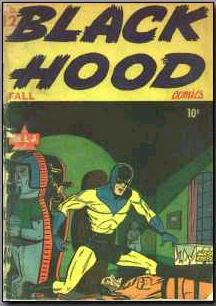Black Hood Comics
| Black Hood Comics | |
|---|---|

Cover to Black Hood Comics #12
|
|
| Publication information | |
| Publisher | MLJ Magazines Inc |
| Schedule | Quarterly |
| Format | Ongoing series |
| Publication date | Winter 1943 – Summer 1946 |
| No. of issues | 11 |
| Main character(s) | Black Hood |
| Creative team | |
| Artist(s) | Raymond Kinstler Bill Vigoda Harry Sahle Clem Weisbecker |
Black Hood Comics was the name of an American anthology comic book series published by MLJ Magazines Inc., more commonly known as MLJ Comics, for eleven issues between Winter 1943 and Summer 1946. The series featured MLJs costumed hero Black Hood, and "Boy Buddies", featuring Shield's partner 'Dusty the Boy Detective' and Wizard's side-kick 'Roy the Superboy', together with humor strips.
Black Hood Comics was published by MLJ Magazines Inc., the precursor to what would become the publisher Archie Comics. The title continued directly on from Hangman Comics, starting from issue #9 (Winter 1943), with a 68-page issue featuring new stories of the costumed hero Black Hood replacing Hangman, and a continuation of the "Boy Buddies" series featuring Shield's partner 'Dusty the Boy Detective' and Wizard's side-kick 'Roy the Superboy' The series was edited by Harry Shorten.
The feature character throughout the series was the titular Black Hood, a masked hero who first appeared in Top-Notch Comics #9 (October 1940). Black Hood appeared in four stories in each issue of Black Hood Comics to begin with, and most issues also carried a Black Hood text story, something all comic books did through the early 1960s, to satisfy U.S. Postal Service requirements for magazine rates. The stories were drawn by a number of artists, including Clem Weisbecker, Bob Fujutani, Bill Vigoda, Irv Novick, Al Fagaly and Raymond Kinstler.
Issues #9 (Winter 1943) and #11 (Summer 1944) also starring "Boy Buddies", the Shield's partner 'Dusty the Boy Detective' and the Wizard's side-kick 'Roy the Superboy' in a dual adventure with art by Bill Vigoda, while issue #10 (Spring 1944) featured a Dusty the Boy Detective solo story, also by Bill Vigoda. The "Junior Flying Corps Club" pages were also continued from Hangman Comics, with plans for making model gliders in issues #9-13, but with issue #14 (Spring 1945) the Club page disappeared, replaced by a true-facts page entitled 'World of Wonder'.
...
Wikipedia
